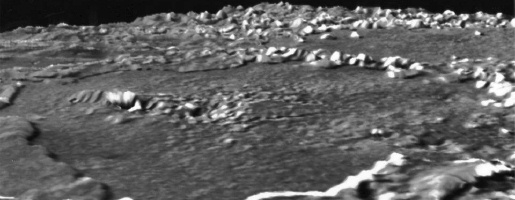 |
||
|
Computer
generated perspective view across Ruach Planitia, possibly an ancient
impact basin.
|
||
| THE SURFACE OF TRITON | ||
| Earth based studies indicated that the surface was composed of frozen nitrogen and methane, which Voyager was able to confirm. Voyager also detected some carbon monoxide ice. | ||
| Although mostly light pink in colour, there are surfaces on Triton which are variously tinged blue, green, yellow or brown. The colours are ascribed to the effect of sunlight on the methane ice to form complex compounds called polymers. The discovery of such photochemicals (chemical reactions caused by light) was a complete surprise. Triton, on average, is 4.5 thousand million kilometres from the Sun. | ||
 The varying colours of Triton's surface. |
||
| Although mostly light pink in colour, there are surfaces on Triton which are variously tinged blue, green, yellow or brown. The colours are ascribed to the effect of sunlight on the methane ice to form complex compounds called polymers. The discovery of such photochemicals (chemical reactions caused by light) was a complete surprise. Triton, on average, is 4.5 thousand million kilometres from the Sun. | ||
| The surface of Triton is extremely varied. Different terrain Types are not evenly distributed and there are few sharp boundaries between different surfaces. There are plains which are smooth and others which are hummocky. The hummocky plains have more craters which helps to identify them as the oldest surfaces on Triton. All types of surface are cut by very long sinuous trenches or "graben". | ||
| The smooth plains are thought to have formed by the eruption of fluids. A mixture of water (H2O) and ammonia (NH3) has been suggested. These plains fill low lying areas. One of the largest eruptions has flooded what is thought to be a large impact basin, in the same way that molten rock has filled impact basins on our Moon to form the maria. | ||
 Ruach Planitia (left) and Tuonela Planitia (right), show evidence of flooding. |
||
| Complex ridge and valley systems criss-cross the surface of Triton. They are interpreted to have formed in cycles of freezing and thawing. This causes the ice surface to expand and contract as the ice changes from one type of ice to another. As ice warms up it alters phase, adopting a less compact molecular arrangement and expanding. This would cause the surface to buckle. | ||
| One of the strangest landscapes in the Solar System is found on Triton. It is called "cantaloupe" terrain because it resembles the skin of a cantaloupe melon, and is thought to be the oldest terrain on Triton. It comprises a network of hummocky ridges which enclose smooth level interiors about 30 kilometres to 50 kilometres across. | ||
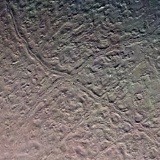 Bubembe Regio exhibits canteloupe terrain, possibly the oldest part of Triton's surface. |
||
| The ridges in the cantaloupe terrain are thought to be made by slushy ice erupting through fissures in the surface. The processes involved in the creation of the ridges may be identical to those that formed the ridges on the surface of Jupiter's moon Europa. | ||
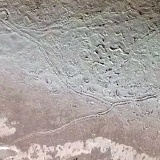 Boynne Sulci (left) and Slidr Sulci (centre), ridges similar to Europa's ridges. |
||
| Found in the cantaloupe terrain are circular dimples which may have been formed by blobs of low density material, possibly water ice and methane, rising from lower levels of the crust to push the surface up. A rising blob would first create bulge which then relaxes to leave a depression. Such a process operates on Venus, forming coronae, but on a much larger scale and involving molten rock. | ||
| Ice Cap | ||
| Triton has a large south polar ice cap. It is brighter than most of the terrain, with an albedo of 0.88, which helps to prevent it from melting away when the southern hemisphere faces the Sun. It seems that the ice cap, like the rest of the surface, comprises methane and nitrogen. | ||
| Variation in the proportions of chemicals detected at the ice cap have led to speculation that the topmost nitrogen layers, during Triton's summer, are vapourised and re-deposited in the northern hemisphere. Because the northern hemisphere was in shadow, Voyager 2 was unable to image the north pole. So it is not known for certain whether or not there is a northern ice cap.The edge of the bright polar cap appears quite rugged. It looks familiar, like the border of a melting patch of snow. It would therefore appear to be retreating. Bright spotted terrain, and round patches with a dark centre surrounded by a bright band, have also been cited as evidence of polar retreat. | ||
| Volcanoes | ||
| Voyager 2 images show geyser-like eruptions on the surface of Triton. They are found in the southern hemisphere and leave a sooty oval-shaped deposit. These eruptions are thought to consist of nitrogen gas and dust particles which give the eruption its dark colour. | ||
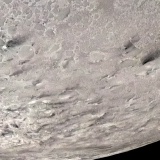 Dark streaks caused by geyser-like eruptions. |
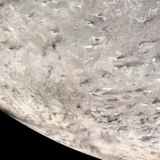 The dark streaks are ten to hundreds of kilometres long. |
|
| A plume caught in action by Voyager rises vertically 8 kilometres above the surface before drifting downwind in a line for about 150 kilometres. | ||
 Image enhancement reveals a plume rising and blowing downwind. |
||
| The plumes may be triggered by the melting of volatiles just below the surface by Triton's warm interior. It has also been suggested they are caused by the melting of a thin nitrogen layer by solar radiation. Sunlight may penetrate the surface ice to heat the nitrogen gases below the surface. As this nitrogen "greenhouse" heats up, the pressure of the vapour increases until it erupts through narrow fissures, taking dust and fine debris with it. | ||
| Craters | ||
| Triton has few craters. The low crater count supports the notion that Triton has been active recently. A former crater population may have been degraded by movement in the surface or buried by volcanic materials. | ||
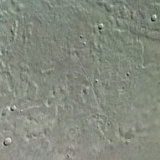 Some of the small number of craters to be found on Triton's surface. |
 Computer generated perspective view across Ruach Planitia, possibly an ancient impact basin. |
|
|
|
||